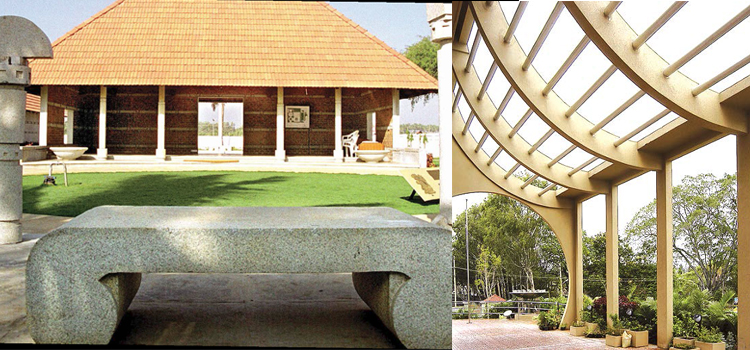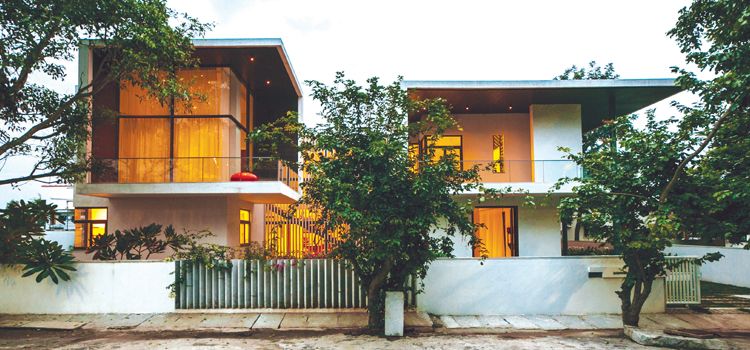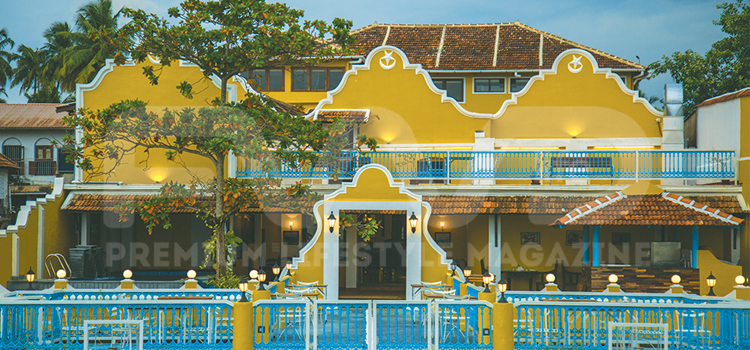Architecture
The Skewed House : Modern and Minimalistic Architecture
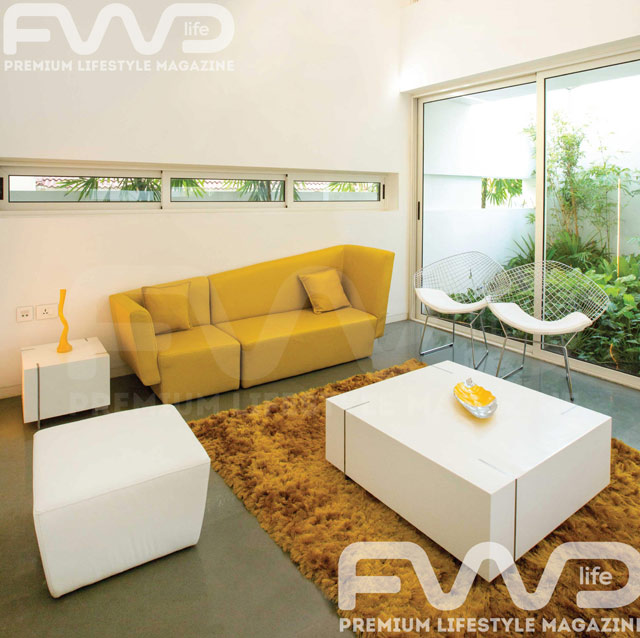
Photos: Suneesh Suresh
The tiled roofs in the neighborhood form an undulating plane of red and brown, sheltering familiar volumes that make a home in Kerala. Cutting through the recognizable fabric, grey concrete fingers reach for the skies along with the mountains in the background. In stark contrast to everything around it, the residence is unapologetically modern and minimalistic. Named Nikunj, which means nest in Sanskrit, the home is a composition of volumes and planes. Known for their unique architectural language, architects Lijo and Reny from Thrissur, have gained yet another feather in their cap, with this award winning residence.
The Skewed House, as the architects refer to it, arises out of a thirteen cent skewed plot. The house remains faithful to its context in terms of climate and requirements but poles apart from the existing aesthetics. The owners of the house, a doctor couple with two children, approached the architect as they wanted something contemporary. They had scoured the web for inspiration and knew that Lijo and Reny could give them their dream home. The home is a sculptural testament to good planning, play of volumes with scale and the modern outlook of the owners.
Sense of existence
Would you conform or would you breakaway? The house asks as you approach it through narrow streets of the residential neighborhood. Music from a nearby temple creates a mystical aura that at first confuses you, then reminds you that we are in India, where disparity is at home. The east facing house breaks out in three bays, which occupies almost the entire plot. A well manicured lawn sits at its foot, which moves into bamboo alcoves perforating the façade. The aluminum grills on the entry side glisten in the morning light and heat. The building certainly makes a statement, frozen in movement against the mountains and the sky.The fenestrations are minimal, as the house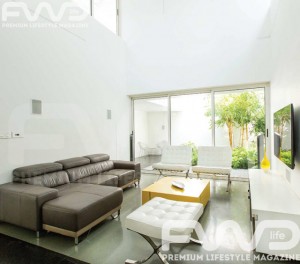 shuts away the busy town to provide a calm and quiet haven inside. Strip windows move across the planes forming the concrete envelope. As majestic as the house is, the entry is subdued and informal. A humble welcome. Past the cheerful frangipani tree, are the glass doors that lead to a simple foyer in the first bay. The leather finished black granite floors feel cool under your bare feet, in contrast to the burning heat of Palakkad town.
shuts away the busy town to provide a calm and quiet haven inside. Strip windows move across the planes forming the concrete envelope. As majestic as the house is, the entry is subdued and informal. A humble welcome. Past the cheerful frangipani tree, are the glass doors that lead to a simple foyer in the first bay. The leather finished black granite floors feel cool under your bare feet, in contrast to the burning heat of Palakkad town.
Visual treats
You will be surprised to find that there are no windows in the house, at least in the traditional sense. The strip windows and one full glass façade in each room, bring in abundant light and a glimpse of the green outside. The transparent surface is visually cut off from the outside with clever planning. The plain white walls and the grey kota floor are accentuated by yellow elements. This theme is followed in the entire house with an element of continuity be it the fluidic vase, details on the tables or the legs of the furniture. The interiors are in the best sense of the word, minimal and they chose striking yellow pieces to energize their space and compliment the greenery which every room is visually connected to. They took two and a half years to furnish the house, and bought only what they felt connected to. The architects also designed iconic pieces inspired by the Nikunj. The box table with steel detailing, the made to order Mies sofa and Bertoia inspired steel furniture add to the contemporary interiors. The home therefore is in perfect sync.
Pragmatic planning
The house was planned out in three bays that lie east-west. One bay housed the functional spaces like kitchen, formal living and dining and another, the bedrooms. The central bay forms the core that connects the functions through a courtyard that brings in abundant light and air into the household. The double height court is protected by stainless 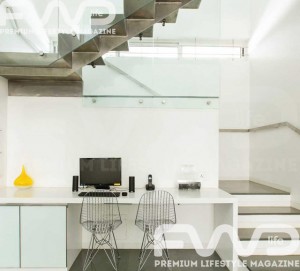 steel grills that throw playful shadows on the tall walls. Red cheeked bulbuls fly through the green, filling the house with their chirps. The home is most beautiful during the rains says the family. A folded stainless steel staircase connects the two levels, which was designed by the architect. Its fluid lines move seamlessly, supported by a single steel member and the glass railing. Your footsteps acquire another rhythm as you move from the SS stairs to the kota laid one. The architect has gone to lengths to explore materials not just in their physical attributes but their sensory ones too. The upper floors have the guest rooms and a party area connected by a bridge overlooking the family room. The roof moves your eyes, bending, pushing and hiding the ducts and a/c components in its aluminum guarded concrete belly. Not even books are visible on the shelves, no kids toys on the table, no handles for the doors or even shampoo bottles in the bathrooms. Everything is tucked away in built in storage. No light fittings jut off the walls. Special LED light strips give ample light in the evenings when the daylight is no longer available. Space and light thus flows unhindered in Nikunj, as the sun moves across the horizon.
steel grills that throw playful shadows on the tall walls. Red cheeked bulbuls fly through the green, filling the house with their chirps. The home is most beautiful during the rains says the family. A folded stainless steel staircase connects the two levels, which was designed by the architect. Its fluid lines move seamlessly, supported by a single steel member and the glass railing. Your footsteps acquire another rhythm as you move from the SS stairs to the kota laid one. The architect has gone to lengths to explore materials not just in their physical attributes but their sensory ones too. The upper floors have the guest rooms and a party area connected by a bridge overlooking the family room. The roof moves your eyes, bending, pushing and hiding the ducts and a/c components in its aluminum guarded concrete belly. Not even books are visible on the shelves, no kids toys on the table, no handles for the doors or even shampoo bottles in the bathrooms. Everything is tucked away in built in storage. No light fittings jut off the walls. Special LED light strips give ample light in the evenings when the daylight is no longer available. Space and light thus flows unhindered in Nikunj, as the sun moves across the horizon.
Architects: LIJO.RENY .architects
Plot: 13.3 cents
Area: 3750 square feet
Materials: concrete, steel, kota, quartz, Corian, granite, aluminium
Architecture
Creating a Cozy Living Room: Tips for Comfort and Style

Your living room is more than just a space for entertaining; it’s a sanctuary where you unwind, relax, and spend quality time with loved ones. Creating a cozy living room involves a blend of comfort and style that makes the space inviting and functional. Here are some tips to help you achieve that perfect balance:
Choose the Right Furniture
Start with furniture that combines comfort and functionality. Opt for a plush sofa with deep cushions, perfect for lounging. Consider adding a cozy armchair or a recliner for additional seating. Make sure the furniture arrangement promotes conversation and allows for easy movement throughout the room.
Layer Your Lighting

Lighting plays a crucial role in setting the mood. Use a mix of lighting sources to create a warm ambiance. Combine overhead lights with floor lamps, table lamps, and wall sconces. For added coziness, incorporate dimmers or smart bulbs that let you adjust the brightness to suit different times of day and activities.
Add Textures with Throws and Pillows
Textures are key to a cozy living room. Layer different fabrics, such as soft throw blankets, plush pillows, and textured rugs. Choose fabrics like wool, velvet, and cotton that add warmth and comfort. Mix and match patterns and colors to create visual interest and a personalized touch.
Incorporate Warm Colors
Color influences the feel of a room. Opt for warm, neutral tones like beige, taupe, or soft gray for a calming effect. Accents in rich colors like deep blues, earthy greens, or warm terracotta can add depth and coziness. Use these colors in your furniture, accessories, and wall decor.
Use Rugs to Define Spaces

Rugs can help define different areas within a living room and add a layer of warmth underfoot. Choose a rug that complements your furniture and adds softness to the space. A large area rug can anchor the room, while smaller rugs can be used to highlight specific areas, like a reading nook or conversation zone.
Incorporate Natural Elements
Bring the outdoors in by incorporating natural elements. Plants not only add a touch of greenery but also improve air quality and create a calming atmosphere. Choose low-maintenance plants like succulents or snake plants if you’re not an avid gardener. Wooden furniture or decor pieces can also add a natural, grounded feel to the room.
Personalize with Artwork and Décor

Add personality to your living room with artwork and decorative items that reflect your style. Choose pieces that resonate with you, whether it’s family photos, abstract art, or vintage finds. Arrange decor items in groups to create visual interest and avoid clutter.
Create a Focal Point
A focal point helps draw the eye and creates a sense of balance in the room. This could be a fireplace, a statement piece of art, or a stylish coffee table. Arrange your furniture and decor around this focal point to enhance the room’s overall cohesion and appeal.
Invest in Quality Window Treatments
Window treatments can impact both the look and feel of your living room. Opt for curtains or blinds that provide privacy while allowing natural light to filter through. Choose fabrics that complement your decor and add texture, such as linen or velvet.
Add Personal Touches
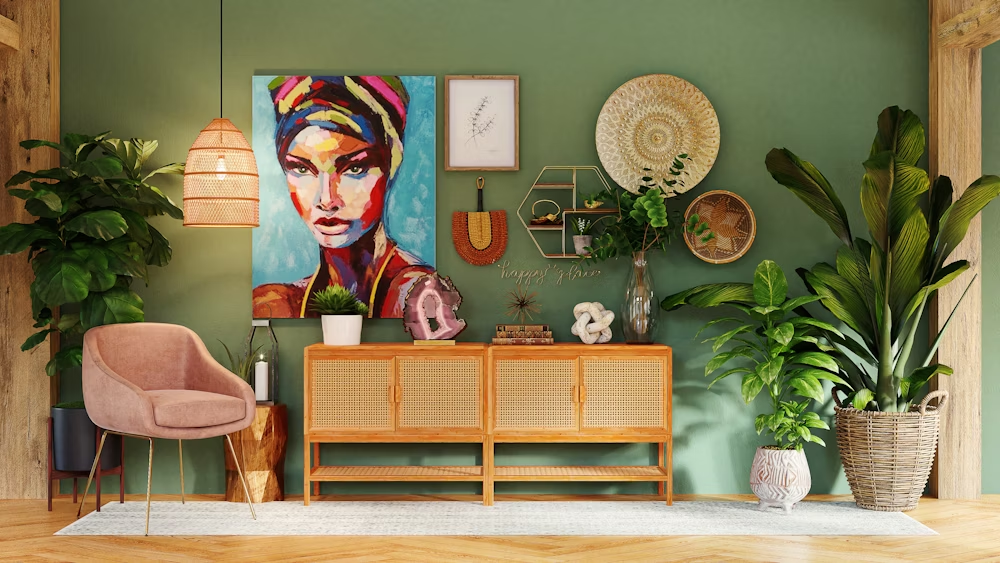
Finally, make the space truly yours by adding personal touches. Incorporate items that have sentimental value or reflect your interests and hobbies. Whether it’s a collection of travel souvenirs, a beloved quilt, or unique decorative objects, these elements will make your living room feel more inviting and personal.
By thoughtfully combining these elements, you can create a cozy living room that serves as a comfortable retreat and a stylish gathering place for friends and family. Enjoy the process of making your space uniquely yours and revel in the comfort and warmth it provides.
Architecture
The Art of Feng Shui: Creating Harmony in Your Home

Feng Shui, an ancient Chinese art and science, is all about creating harmony and balance in our living spaces. By arranging our homes in accordance with Feng Shui principles, we can invite positive energy, known as “chi,” into our lives and promote health, wealth, and happiness. In this blog post, we’ll explore the fundamentals of Feng Shui and share practical tips for applying its principles to create a harmonious and inviting home environment.
Understanding the Basics of Feng Shui:
Feng Shui is based on the concept of “chi,” or life force energy, which flows through our environments and influences our well-being. The goal of Feng Shui is to create a harmonious flow of chi by arranging our surroundings in a way that promotes balance and harmony. This includes paying attention to the layout, orientation, and organization of our homes to optimize the flow of energy.
The Five Elements of Feng Shui:
In Feng Shui, there are five elements—wood, fire, earth, metal, and water—that represent different qualities and energies. By incorporating these elements into our home decor, we can create a sense of balance and harmony. For example, wood represents growth and vitality, while water symbolizes flow and abundance. By incorporating a balance of these elements into our living spaces, we can enhance the flow of positive energy and create a sense of equilibrium.
Applying Feng Shui Principles to Your Home:
Clearing Clutter: Clutter can block the flow of chi and create stagnant energy in our homes. Start by decluttering your space and getting rid of items that no longer serve a purpose. This will create space for fresh energy to flow and rejuvenate your home.
Balancing Yin and Yang: In Feng Shui, yin and yang represent the balance of feminine and masculine energies. Create a harmonious balance of yin and yang in your home by incorporating soft, nurturing elements (yin) with strong, active elements (yang).
Enhancing the Flow of Chi: Pay attention to the layout and arrangement of furniture in your home to optimize the flow of chi. Avoid placing furniture in direct line with doorways or blocking pathways, as this can disrupt the flow of energy. Instead, create open and inviting spaces that allow chi to circulate freely.
Incorporating Nature: Bring the outdoors in by incorporating elements of nature into your home decor. Plants, natural materials, and natural light can enhance the flow of chi and create a sense of vitality and well-being in your living spaces.
Room-By-Room Feng Shui Tips:
Living Room: Arrange furniture in a circular or semi-circular layout to encourage conversation and social interaction. Use soft, natural fabrics and incorporate elements of wood and fire to create warmth and intimacy.
Bedroom: Position your bed diagonally across from the door to command a clear view of the room while you sleep. Keep the space under your bed clear and clutter-free to promote restful sleep and relaxation.
Kitchen: Keep your kitchen clean, organized, and clutter-free to promote health and abundance. Incorporate elements of fire and earth, such as candles and earthy tones, to create a warm and inviting atmosphere for cooking and dining.
By incorporating the principles of Feng Shui into your home decor, you can create a harmonious and balanced living environment that supports your health, happiness, and overall well-being. Whether you’re decluttering your space, balancing yin and yang energies, or enhancing the flow of chi, the art of Feng Shui offers timeless wisdom and practical guidance for creating a sanctuary of peace and tranquility in your home.
Architecture
5 Sustainable Interior Design Trends to Embrace in 2024

As the world becomes increasingly aware of the importance of sustainability, it’s no surprise that eco-friendly practices are making their way into the realm of interior design. In 2024, we can expect to see a surge in sustainable interior design trends that not only enhance the beauty of our living spaces but also minimise our environmental footprint. From repurposed materials to energy-efficient solutions, here are five sustainable interior design trends to embrace this year.
Upcycled Furniture:

One of the most prominent sustainable interior design trends of 2024 is the use of upcycled furniture. Instead of buying new pieces, consider giving old furniture a new lease on life by refurbishing or repurposing them. From reclaimed wood tables to refurbished chairs, upcycled furniture adds character and charm to your space while reducing waste and conserving resources.
Biophilic Design:

Biophilic design, which emphasizes a connection to nature, continues to gain popularity in 2024. Integrating natural elements such as plants, natural light, and organic materials into your interior design not only enhances aesthetics but also promotes well-being and sustainability. Consider incorporating living walls, indoor gardens, and sustainable wood finishes to bring the outdoors inside and create a healthier living environment.
Energy-Efficient Lighting:

With a growing focus on energy conservation, energy-efficient lighting solutions are becoming a staple in sustainable interior design. LED lights, in particular, consume significantly less energy than traditional incandescent bulbs and last much longer, reducing both energy consumption and maintenance costs. Additionally, consider incorporating natural light sources such as skylights and large windows to maximize daylight and minimize the need for artificial lighting during the day.
Sustainable Textiles:

When it comes to upholstery and soft furnishings, opting for sustainable textiles is key to reducing environmental impact. Look for fabrics made from organic or recycled materials, such as organic cotton, hemp, bamboo, or recycled polyester. These materials not only reduce the use of harmful chemicals and pesticides but also minimize waste and support eco-friendly production practices. Additionally, consider investing in durable, high-quality textiles that stand the test of time, reducing the need for frequent replacements.
Smart Home Technology:

In 2024, smart home technology continues to evolve, offering innovative solutions for sustainable living. From smart thermostats that optimize energy usage to home automation systems that control lighting and appliances, these technologies can help reduce energy consumption and increase efficiency in your home. Additionally, smart home devices such as occupancy sensors and smart meters provide valuable insights into your energy usage, empowering you to make informed decisions about resource management and conservation.
As we strive to create more sustainable living environments, embracing these five interior design trends can help reduce our environmental impact while creating beautiful and functional spaces. Whether you’re upcycling old furniture, incorporating natural elements, or investing in energy-efficient technologies, every sustainable choice contributes to a greener future for generations to come. So let’s embrace these trends and make sustainability a cornerstone of our interior design practices in 2024 and beyond.
-

 Style10 months ago
Style10 months agoBridal Guide : Best Looks of Radhika Merchant Ambani
-

 Entertainment1 year ago
Entertainment1 year agoThe Stunning looks from Bhagya Suresh’s Wedding
-

 Fashion1 year ago
Fashion1 year agoMost Discussed Ajrakh Saree of Alia Bhatt
-

 Entertainment1 year ago
Entertainment1 year agoThe Most Stylish Guests of Bhagya Suresh Reception
-

 Entertainment1 year ago
Entertainment1 year agoBridal Bliss : All Bridal Looks of Swasika Vijay
-

 Movies1 year ago
Movies1 year agoA Nostalgic Journey Through Love &Cinema : Best Bollywood Romantic 90s Movies
-

 Entertainment1 year ago
Entertainment1 year agoEverything about the Ira Khan wedding that is out of the norm
-

 Fashion1 year ago
Fashion1 year agoMajor Denim Trends You Need To Know in 2024







